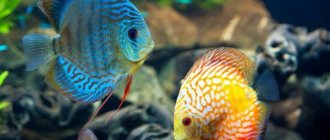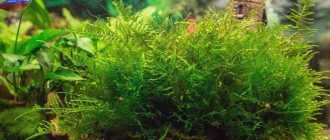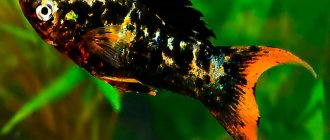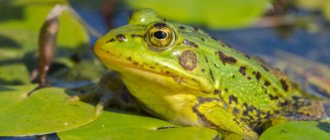Mollies - one of the most popular aquarium inhabitants. Such popularity has led to the fact that mollies have undergone serious breeding work aimed at obtaining various color morphs through hybridization.
Yellow or golden mollies
Black and yellow mollies photo
What kind of mollies swims in your aquarium? We can 99.99% believe that this is not a natural form , but a morph. Mollies now in aquariums are almost exclusively hybrids. Both supposedly “latipinae” and supposedly “velifers” are all selection morphs. All mollies with a small dorsal fin are hybrids of Sphenops and Mexican mollies. And all with a large dorsal fin are hybrids of Sphenops, Latipinna and Velifera. So, something like that, friends! Morphs have taken over our aquarium world. Whether it’s good or bad, let everyone decide for themselves.
The yellow ibn golden mollies is one of the variations of hybridization; it is a colored morph with possibly additional structural changes in the fins and body, originally obtained from the above natural forms of mollies.
Molly good video review
Subscribe to our YouTube channel so you don't miss anything
From the horror stories of hybridization, let’s say that all fish are “balloons”, including the balloon mollies - this is a selective fixation of a mutation-deformity that arises due to inbreeding (crossing of closely related forms).
Just like all Xanthorist breeds, these are aquarium discoloration mutations. Their breeders fix them genetically. Xanthorists are fish that are discolored by developing a yellow tint instead of red or green. Yellow mollies - xanthorista. White, albinos are super xanthorist freaks. All these are scientific terms without any hype. A freak is an individual with congenital body defects, possibly due to a genetic defect or exposure to negative factors in the embryonic period. And period.
And you say that GLO-fish is wow wow. Here, before Glo, how much wood humanity has chopped up, so mother, don’t worry.
As for the conditions for keeping yellow mollies , they are standard for all varieties.
Latin name: Poecilia.
Family: Poeciliaceae.
Comfortable water temperature: not lower than 25 degrees, preferably 27. Mollies are heat-loving, and do not tolerate low temperatures well.
Acidity pH: 7-8, which is typical for many viviparous fish - they love a slightly alkaline environment.
Hardness dH: 7,0-8,0.
Behavior: Peaceful, but nimble - fidgety fish.
How long they live: up to 4 years.
Content difficulty: easy.
Molly compatibility: viviparous fish - platies , swordtails ; labyrinthine - gourami , lalius ; non-aggressive and small “dwarf cichlids ”, angelfish , even cockerels (it is worth noting that angelfish and cockerels are soft-water fish, which does not really coincide with the water parameters for mollies).
Appearance, structure of mollies
Mollies are a species of viviparous ray-finned fish of the Poeciliidae family. Life expectancy in an aquarium is up to 5 years. In the natural environment, females grow up to 12 cm, males - up to 8 cm.
The shape of the body is elongated in length, and seems to be slightly compressed at the sides. The fish have fairly large eyes and a not very large head. Most species of mollies have short fins. As an exception, it is worth noting the velifera, which is decorated with a highly developed dorsal fin with a rounded edge.
In nature, the main color is silver or yellowish-gray, with specks scattered over the entire surface. The color of the spots can range from bluish-gray to gray-bluish and yellow-green. But thanks to enormous selection work, aquarium mollies have a variety of colors - white, deep black, yellow and other colors. During selection, it was possible to breed species with different shapes of fins and bodies. For example, cylinders with a short body and a characteristic convex abdomen are popular among aquarists.
Adviсe
- Keep with slow or too fast fish, to which mollies are indifferent.
- Do not introduce veil-tailed fish with long fins.
- Watch your fish diet and avoid overeating.
- Monitor the number of fish in the aquarium and prevent overpopulation, because mollies reproduce every 1.5 months and without control will quickly increase the number of inhabitants.
Due to the color scheme and ease of keeping, the yellow molly will for a long time be the standard of the first fish that every beginning aquarist should have.
Previous
FishGurami honey - the smallest of the colis
Next
FishHow to ensure good care for Astronotus cichlid
Mollies habitat
Habitat is Central America, the southeastern part of the USA, eastern and northern South America. Thanks to their unpretentiousness and endurance, they managed to populate such vast territories with different conditions. They live not only in bodies of fresh water, but also in estuaries - places where rivers meet the oceans, where the water has a high level of salinity.
Different types of mollies prefer different regions. Thus, the sphenops molly (lat. Poecilia sphenops) can be found in large numbers in reservoirs from Colombia to Mexico, and the velifera molly (lat. Poecilia velifera) lives on the Mexican Yucatan Peninsula. Southern states of the USA, in places where the water has increased salinity, mollies latipin.
In modern conditions, fish are grown en masse on farms, especially common in Southeast Asia. And from there they go all over the world to delight aquarists.
Feeding
There are store-bought foods made specifically for molly.
Thanks to the omnivorous nature of mollies, you don’t have to worry too much about food. The main rule is that the amount of plant food should be overwhelming. Regardless of what kind of food you offer (dry food or live food), some types of mollies will show their gluttony over and over again. But you shouldn't feed the fish. Overeating will definitely have a bad effect on their health.
Tubifex bloodworms, daphnia, and brine shrimp are good options. In the wild, mollies happily consume algae, and these fish cannot be deprived of plant fiber at home. A good option for this food is spirulina flakes. “Regular” foods from the refrigerator are also suitable - slices of cucumber, zucchini, lettuce. In summer, you can add dandelion to your diet. Any plant should be scalded with boiling water immediately before feeding.
History of discovery
Achille Valenciennes
Mollies sphenops is the first species in history, which was described by the French zoologist Achille Valenciennes back in 1846. At this time, he was working on writing his 22-volume work, “The Natural History of Fishes.”
50 years have passed, and two species at once fell under the description - velifera and free-ranging mollies. This merit belongs to the ichthyologist-systematist Charles Tate Regan.
1913 - The first wild mollies latipin arrives in Europe.
Charles Tate Regan
Interestingly, the fish were originally assigned to the genus Mollienesia. But modern classification has made clarifications, and now they belong to the genus Poecilia. And their very name Mollienesia is a historical legacy from the original classification.
The year 1920 can be marked as the year of the beginning of active breeding work to develop new forms of mollies. Thanks to the successful crossing of species such as Sphenops, Velifera and Latipine, new hybrids began to appear one after another. A major achievement was the introduction of the black and speckled uniform in 1925. But perhaps the most famous and popular breed was the black-velvet molly, called Black Molly. In the mid-twentieth century, it was so popular that even today, when many lovers mention mollies, they first of all associate with Black Molly. One of the latest breeding trends has been the breeding of mollies, which, due to their similar shape, are called balloons.
Interesting Facts
- In all species of mollies, females are larger than males . Females of Molliesia velifera reach up to 18 cm, Molliesia latipinna - 10 - 12 cm, and Molliesia sphenops - 6 - 8 cm. Sex is determined in the same way as in other viviparous animals, by the shape of the anal fin.
- The most common forms of mollies currently on sale are purely black, artificially bred forms. However, litters of black Mollies, as hobbyists call them, usually produce a number of spotted fish, with black scales interspersed with light and bluish-green scales, like the original form.
- Mollies are critical to the illumination of the aquarium - daylight hours should last at least 13 hours. Lighting 0.5 - 0.7 W/l lamps with an enhanced red part in the spectrum. Preferably 2 hours of natural sunlight.
- Mollies are omnivores , so they can be fed with any live, dry or plant food (including algae). The diet of mollies must necessarily contain herbal supplements. Make sure your fish's diet is varied enough.
- Varieties of these mollies have been developed relatively recently. Fork mollies - with a cut-out tail and with elongated upper and lower ends, and scarf mollies - with an elongated dorsal fin.
Video
Types of mollies
In nature, there are only 4 types of mollies:
- lat. Poecilia sphenops - molly sphenops,
- lat. Poecilia latipinna - molly latipinna,
- lat. Poecilia salvatoris - free mollies,
- lat. Poecilia velifera - velifera molly.
Mollies sphenops
The body of this fish is quite dense, it is elongated and laterally compressed. The tail is rounded, the fins are medium-sized. The structure of the mouth allows it to eat food from the surface of the water, as well as scrape algae from the walls of the aquarium and decor. Body size is 6-10 cm. Females are always slightly larger than “gentlemen”. The anal fin of males is transformed into a gonopodium.
The most popular color of sphenops is pure black. There are also others obtained artificially, for example, speckled, white, yellow. The caudal fin most often has a lyre-shaped shape.
Valuable specimens include mollies with black velvety scales with spots on them. The body of such fish does not shine due to its matte color. In addition, such large black eyes are almost invisible.
You won't have any problems choosing neighbors for this fish, because... she is very peaceful. It is worth considering that sphenopsas are very jumpy, so be sure to ensure that you have a lid on the aquarium.
In order for sphenops to feel comfortable, it is worth providing the following water parameters:
- hardness - 11–30 dGH;
- temperature - 25–28°C;
- PH = 7.5-8.2.
Mollies lapitina
The second name is broad-finned mollies. It is a “smaller copy” of velifera. The fish has a dense, elongated body, which is flattened on the sides. The high dorsal fin is shaped like a rectangle and consists of 12-14 rays. The caudal fin has a rounded shape. Males have a gonopodium, an organ for reproduction.
As a rule, females are slightly larger than males. Males in an aquarium grow up to 10 cm. When keeping this breed, it is worth considering that the fish love bright lighting. Their lifespan in an aquarium is 3-5 years.
The body color is bluish-gray, in the male it has a greenish-blue tint. On the sides there are whitish shiny dots that form rows. The lower part of the body is bright orange, the fins are blue with an orange border, they are covered with multi-colored strokes and dots. The lifespan of this species in an aquarium is 3-5 years.
Required water parameters for maintenance:
- PH = 7.5–8.0;
- temperature – 24–26°C;
- hardness – 15-20 dGH.
Molliesia free
Free mollies can often be seen in home aquariums. For a long time it was considered a color variation of Sphenops, but today it has been identified as a separate species. The fish lives in the waters of Guatemala.
Free mollies have a beautiful color. Its silvery-yellow body can have a bluish tint, the dorsal and pelvic fins are very bright, they can be white, black, or red. Pisces are easy to care for and peaceful. The requirements for water parameters are the same as for mollies sphenops.
Molliesia velifera
This species is also called sailfin molly. The fish got its name due to the well-developed dorsal fin of the male (4-5 cm), which looks like a fan. The fish is quite large in size: in natural conditions it grows up to 17 cm, in an aquarium – up to 13 cm.
The natural body color is silver with horizontal dotted lines. The front of the body of males may be orange. The caudal fin is turquoise along the contours, orange in the middle, and the dorsal fin has an orange or black edging. In females, the body is gray-green and has dotted lines.
It is worth considering that keeping this type of fish requires adding sea or table salt to the water. The minimum volume of the aquarium is 100 l, because the fish is very active. When choosing neighbors, choose representatives of a peaceful nature. Not the best option is Sumatran barbs, which can pluck the fins of mollies.
Water parameters:
- PH = 7.0–8.5
- temperature – 24–27°C
- hardness – 8–25 dGH.
There are many breeding varieties, and they all differ in shape, size and color.
Diseases
- Gas embolism is manifested by an excess of oxygen in the fish’s body, due to which the blood vessels close. It manifests itself as bruises and bruises on the body, cloudy eyes, lethargy, and anxiety. To avoid this, carefully monitor the aquarium aeration process.
- Colds are caused by sharp drops in temperature, which is very dangerous for heat-loving mollies. The fish refuse to eat and become passive. For treatment, it is enough to return the temperature to levels that are comfortable for the inhabitants.
- Ecto- and endoparasites. If you do not keep the aquarium clean, parasites enter the fish's body. Golden mollies will fuss, get nervous, rub against the walls of the aquarium and stones, and refuse food. Treatment with antibiotics or baths with solutions.
- Infection. A dirty aquarium leads to infectious diseases; pets are passive, photophobic, and nervous. Treatment with antibiotics.
Popular breeding forms of mollies
Golden - have a bright yellow-orange color, which has a white-blue tint. Some individuals have red eyes.
Silver (another name for Snowflakes) - the body is painted white with a beautiful silver tint. They sparkle like snow in the sun, which was the reason to call them snowflakes.
Balloon - characteristic features of this breed are a swollen abdomen and a shortened shape. The color can be different - from orange and red to white and black.
Mollies with a lyre tail - the tail has a lyre shape, which gives it originality. The length of the tail rays may vary.
Some features
Sometimes completely black parents can give birth to snow-white fry. This is due to both genes (one of the ancestors was white) and the presence of an albino form in mollies. The white color does not necessarily persist into adulthood. During the first month, black dots may appear on the body of the white fry, which increase with age and may even multiply. At 6-7 months, such a molly may already have a black body color, and only in the front part of the back and chest there are white and iridescent spots.
Maintenance and care
The ability of this type of fish to adapt to different conditions is amazing. But since the goal of the aquarist is the pleasure of observing the inhabitants of the aquarium, and not a quest for survival, it is recommended to create optimally favorable conditions for a comfortable and healthy life for the fish.
Aquarium volume
Since mollies are schooling fish, it is recommended to form small groups of 6-10 individuals. An aquarium from 50 liters is suitable for these purposes. For the velifer type, which has larger dimensions (up to 17 cm), the volume should be from 100 liters. The shape of the aquarium must be rectangular and must have a lid. Fish often swim in the upper layers, they are very mobile, the presence of a lid will prevent them from jumping out.
Light
Make sure you have good additional lighting. Provide at least 12 hours of daylight.
Water parameters
This type of fish loves warm water (permissible range 23-28°C, optimal – 24-26°C). It is very important to avoid fluctuations in water temperature, as they have a negative impact on the health of the fish. The best option is neutral or slightly acidic water with pH = 7-8. However, soft water is not very suitable for them; the recommended hardness is from 10 to 20 ° dGH.
Some varieties do well in salted water. Therefore, there are recommendations to add sea salt (up to a concentration of 2-3 g/l). But there is an important nuance here - this is only permissible for species aquariums. If there are other fish living in the aquarium, then the increased salinity of the water will negatively affect their health and well-being.
Once every 7 days, a water change of 25-30% of the total volume is required. Mollies subtly react to the purity of water and serve as a real indicator of it. If there is a high accumulation of waste products in the water, then they fold their fins and slow down their movement (which is not typical for such active fish) or move jerkily. And when there is a lack of oxygen, mollies are among the first to constantly strive to stay near the surface of the water.
Soil selection
Choose pebbles (3-5 mm), it is better that they are dark in color and can be used for planting living plants.
Vegetation and scenery
It is important to provide room for swimming. It is necessary to create green islands of dense vegetation with islands for swimming. It should be taken into account that fish can eat up delicate leaves and are also able to scrape off algae growth from the surface of the soil and decorations. As decoration, you can place several natural driftwood at the bottom. They will serve as a shelter for females who are not ready to spawn from overly annoying gentlemen.
Equipment
It will be necessary to equip the aquarium with a filter (of suitable power - depends on the volume of the aquarium), a thermostat (the power also depends on the volume of the aquarium) and an aerator (desirable, but not necessary, as some modifications of internal filters have the function of saturating the water with oxygen).
Features of feeding
Another advantage of mollies is their omnivorous nature. It is not recommended to exclude plant foods - the lack of fiber can lead to disturbances in the gastrointestinal tract. If there is no plant food in the diet, then the fish will probably begin to actively eat algal fouling on the glass, as well as plant leaves. All forms of food should be used for mollies.
Feeding is carried out several times a day, but portions should be small. Mollies have a tendency to overeat, so one fasting day a week is a good idea.
Reproduction
Molly fish are viviparous, which means they do not carry eggs. These platies reach sexual maturity at 9-12 months, the fry develop in utero for 35-40 days. For breeding, it is not necessary to allocate a separate aquarium for mollies, but for the successful raising of offspring it will definitely be required, because the female gives birth to 30 to 60 small individuals at a time (large females can give birth to up to 100 fry). After giving birth, the female should be removed so that she does not eat the newborns. It is useful for fry to change the water more often and add a little salt to prevent infections .
Mollies are perfect for beginner aquarists.
Southern babies are as unpretentious as guppies, which means it won’t be difficult to keep these aquarium inhabitants looking attractive and healthy.
Compatibility
Peacefulness is another positive characteristic of mollies. It makes them convenient for keeping in community aquariums. At the same time, in order to avoid conflicts within the mollies flock itself, it should be dominated by females at the rate of 3-4 females per male. When choosing neighbors, it is recommended to give preference to fish that are similar in size. The fish get along well with zebrafish, catfish, and ancistrus.
All species, except Velifera, are able to get along with barbs. To keep them in a community aquarium, take care to arrange shelters made of driftwood and grottoes. Neighborhood with aggressive species, such as cichlids, is not recommended.
mollies compatibility table
Fish diseases
The ailments of the individual, like other viviparous representatives of the water element, are associated with an imbalance in maintenance and feeding. The causes of the disease may include the following:
- deviations of temperature and acidity regimes of water from the normal level;
- periodic overfeeding of individuals;
- colds and infections;
- improper change of water environment;
- improper transportation of peace-loving fish.
The following pathological conditions indicate the disease:
- the appearance of local areas on the body covered with small bubbles and mossy formations;
- the formation of dark marks, light spots, tumor formations on the fins;
- general lethargy, irrational trajectory of movement, sinking to the bottom, refusal to eat;
- visual bulging of the eyes.
Diseases of Mollies
Mollies are most often susceptible to the following types of diseases:
- Change of color - melanosis, excess pigmentation turns into a tumor.
- Ichthyophthiriasis, or the so-called fish louse, is a parasitic attack on delicate scales.
- Invasive diseases.
- Ingestion of a foreign body. In this case, the molly begins to move extremely irrationally, often falling to the bottom head down.
- Exophthalmos is fish-like protruding eyes, often leading to loss of vision and death.
- Gas embolism. It is formed as a result of excess oxygen content in the aquatic environment. This phenomenon occurs when the tank is filled with unsettled tap water. The disease is characterized by restlessness and darkening of the gills. Care and therapy here takes place in the form of an urgent change of the aquatic environment.
- Melanosis. The body is covered with blots of non-standard color, which later transform into tumors. This pathology cannot be cured. Preventive measures consist of creating comfortable living conditions; this pathology can be solved in this way. Only tracking key indicators will help you avoid these destructive conditions.
- Cold. If lethargy and apathy appear in the behavior of individuals, they begin to swim near the surface, they experience loss of appetite, then all this indicates a possible cold. The disease attacks when the temperature drops. Care and therapy in this case consists of creating a comfortable temperature regime.
- Hexamitosis in mollies.
Why do mollies die?
Harmful ammonia, nitrates and nitrites begin to rapidly accumulate in the aquarium environment. All these harmful components have a detrimental effect on the protective properties of the fish’s body. It is extremely difficult to cure her of this condition. If timely measures are not taken, this entails the death of the individual.
If intoxication with harmful substances does occur, the following actions will help:
- Regularly change the cloudy liquid to purified water.
- Carrying out a test for the oxygen content in an aquatic environment, using it you can also find out the content of NH4, NO3, NO2. These actions will help bring the indicators back to normal.
- White spots on the body of an individual will disappear when the temperature in the aquarium increases, adding salt and effective antibiotics, increasing the temperature regime.
- If a specimen has bulging eyes, this can cause an infection. In this case, therapy may be required.
Treatment
The nearest pet store has effective remedies for various ailments. The main task of the aquarist is to accurately determine the symptoms. Many ailments arise due to an imbalance in living conditions:
- water filtration;
- necessary aeration;
- insufficient aquarium volumes.
When an illness is detected, the following remedies are often used:
- Effective Tetra Contralck against destructive ciliates, flagellated bacteria (ichthyophthiriasis, semolina, the appearance of white spots).
- Sera bakto Tabs help cope with internal bacterial infections.
Before using a particular medicine, study the description of its properties in detailed instructions.
Prevention
To avoid the development of an unwanted disease, preventive measures are mandatory:
- Regularly change dirty and stale aquarium fluid.
- Cleaning the tank.
- Temperature control.
All these measures will help not only revitalize the aquarium space, but also produce healthy offspring.
Price
The current retail market for aquarium fish offers the widest selection of species and color forms of mollies or, as they are correctly called on labels and price tags, platies. Fish of simple and common colors are sold at prices starting from 50 rubles. White molly , or “snowflake”, is already more expensive, costing 100-150 rubles. And so on.
Guppies, which sellers never mix with other species and sell as an independent variety, start at 90-100 rubles. Private breeders-sellers ask for a lower price than stores. Who has a better quality product, whose fish will live longer is unknown.
The final price is affected by the color; in addition, larger fish are more expensive. The size of the fish indicates not only and not so much the age, but rather the conditions under which the fish are kept. Breeders of aquarium fish keep them in crowded conditions. Only with decent maintenance do fish have a chance to grow to their nominal size.











